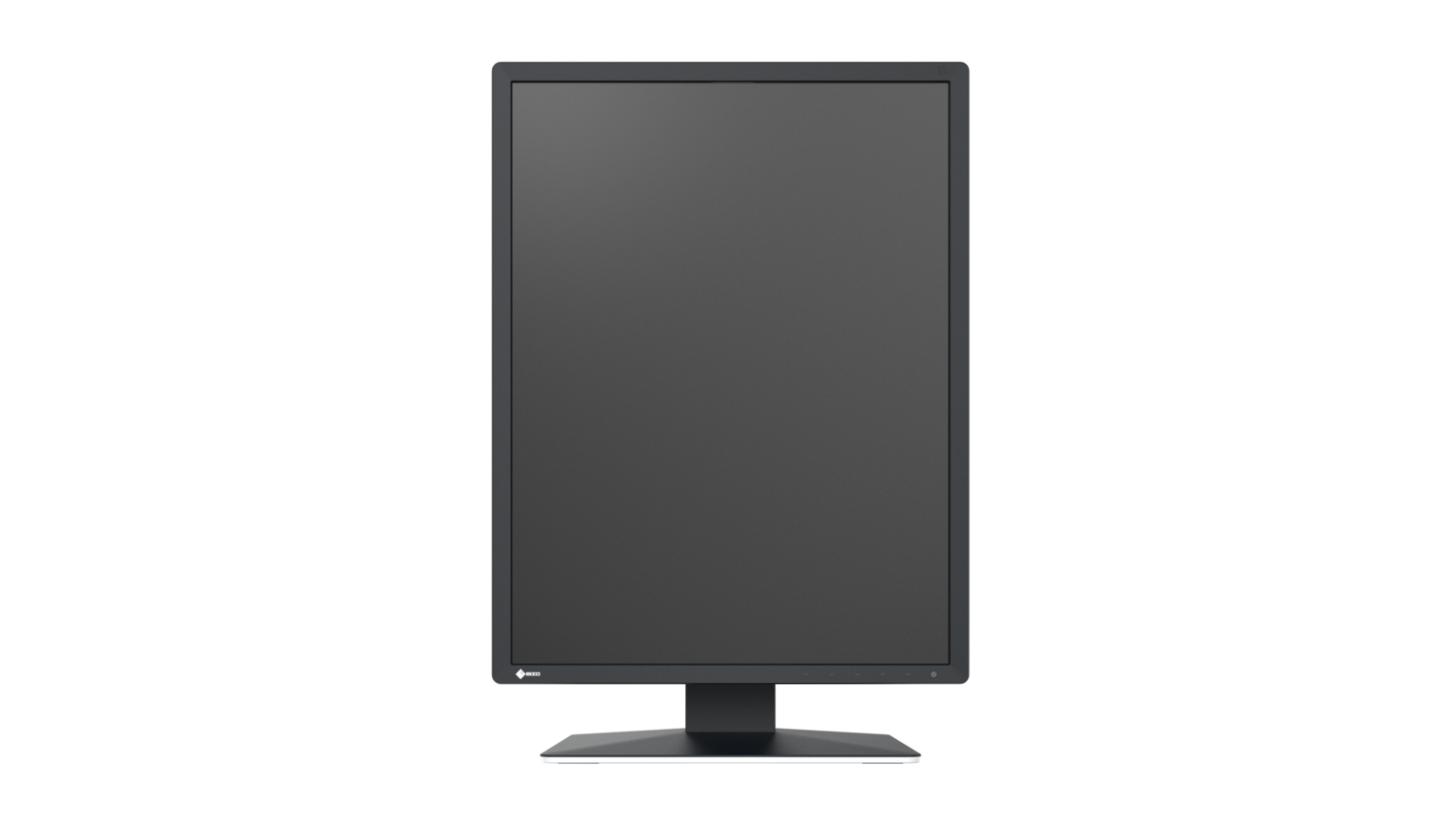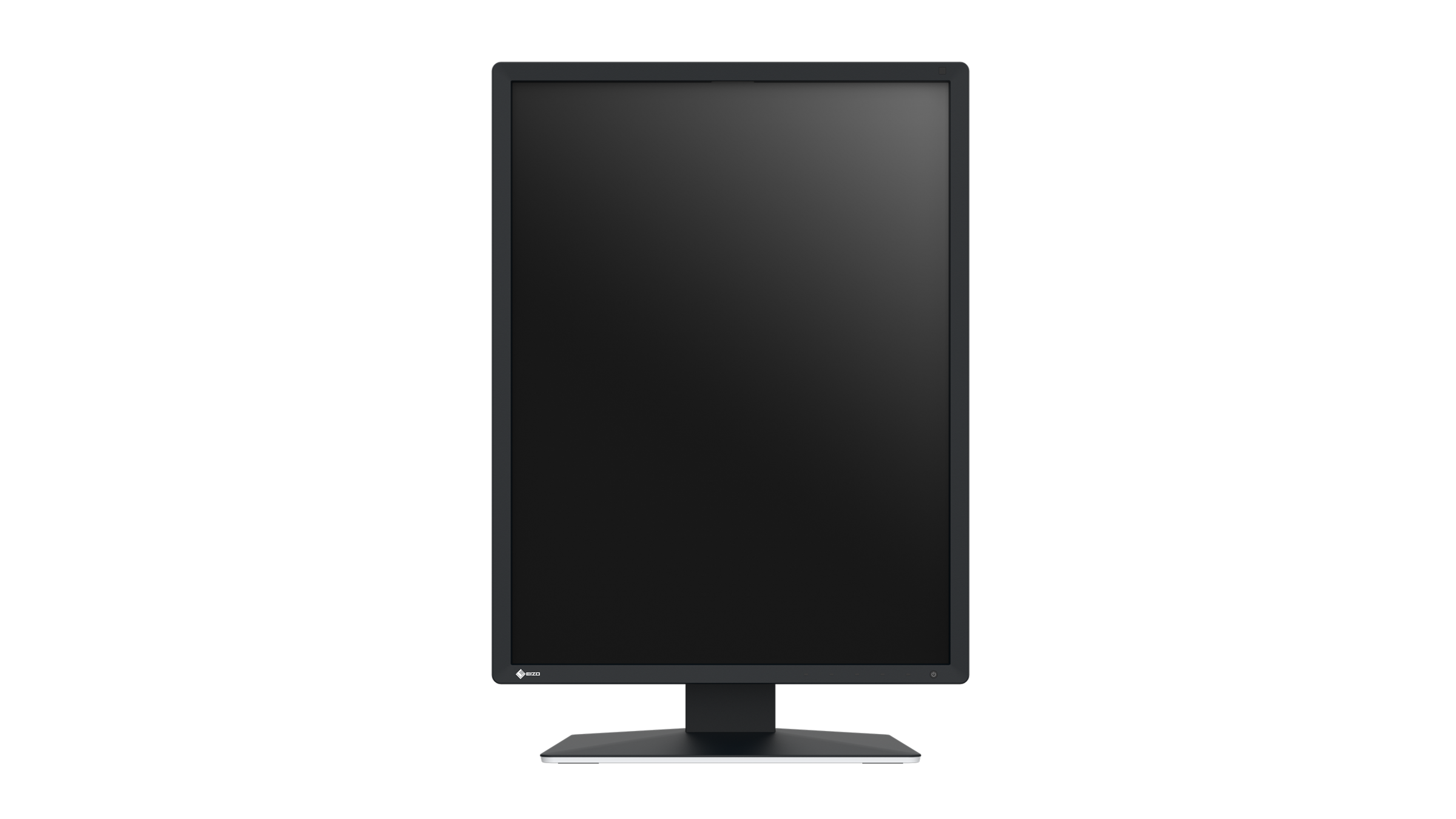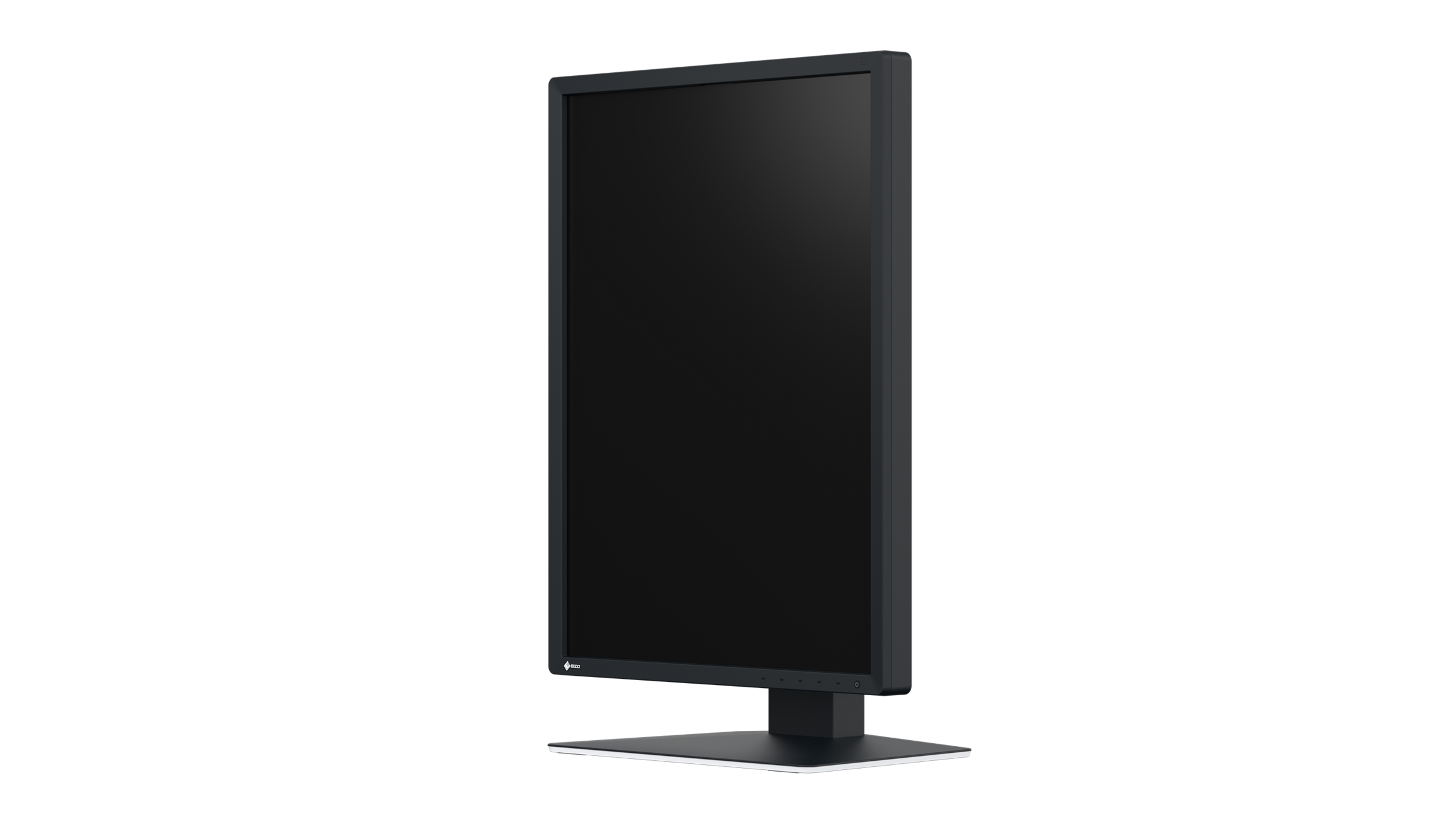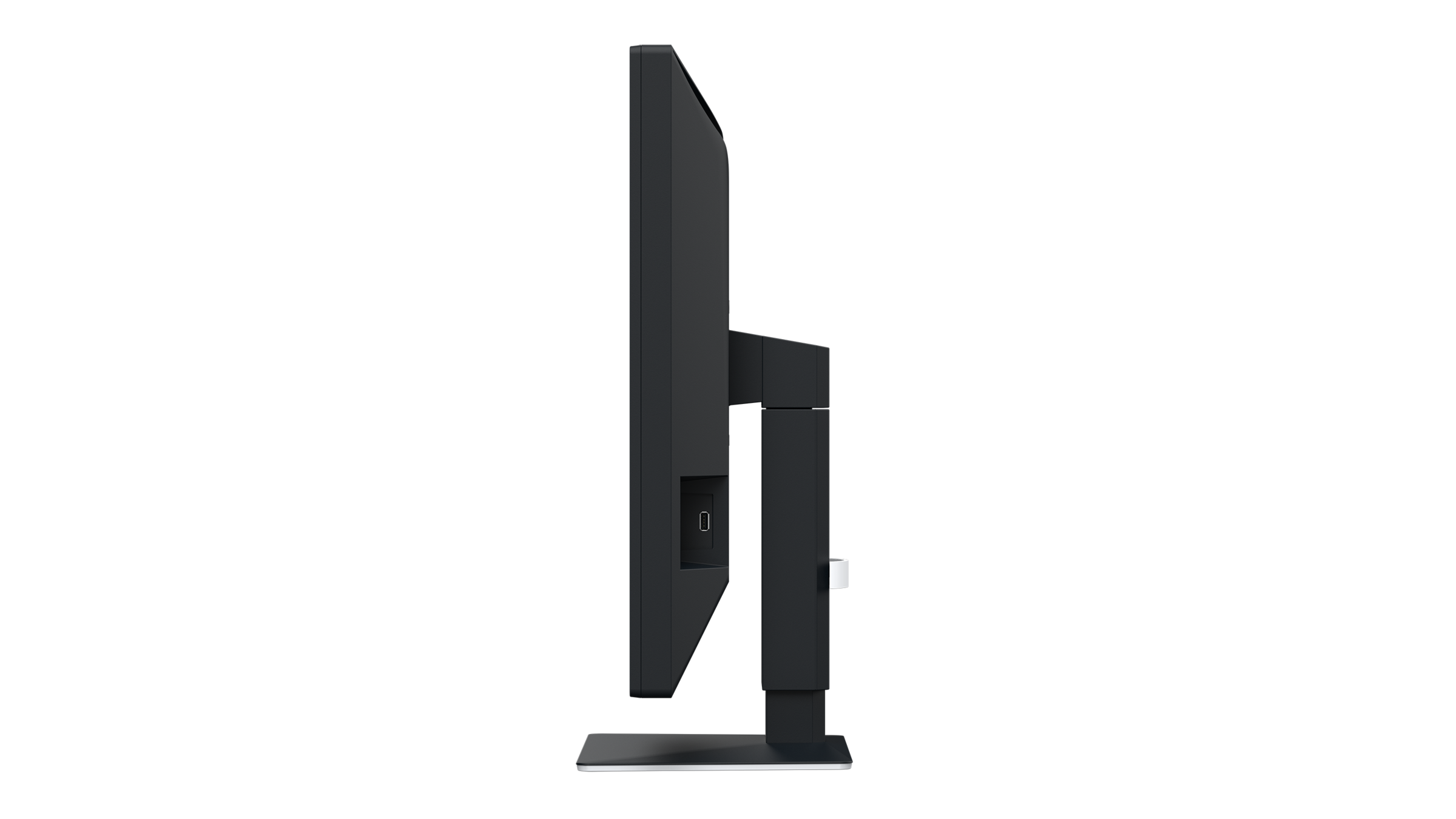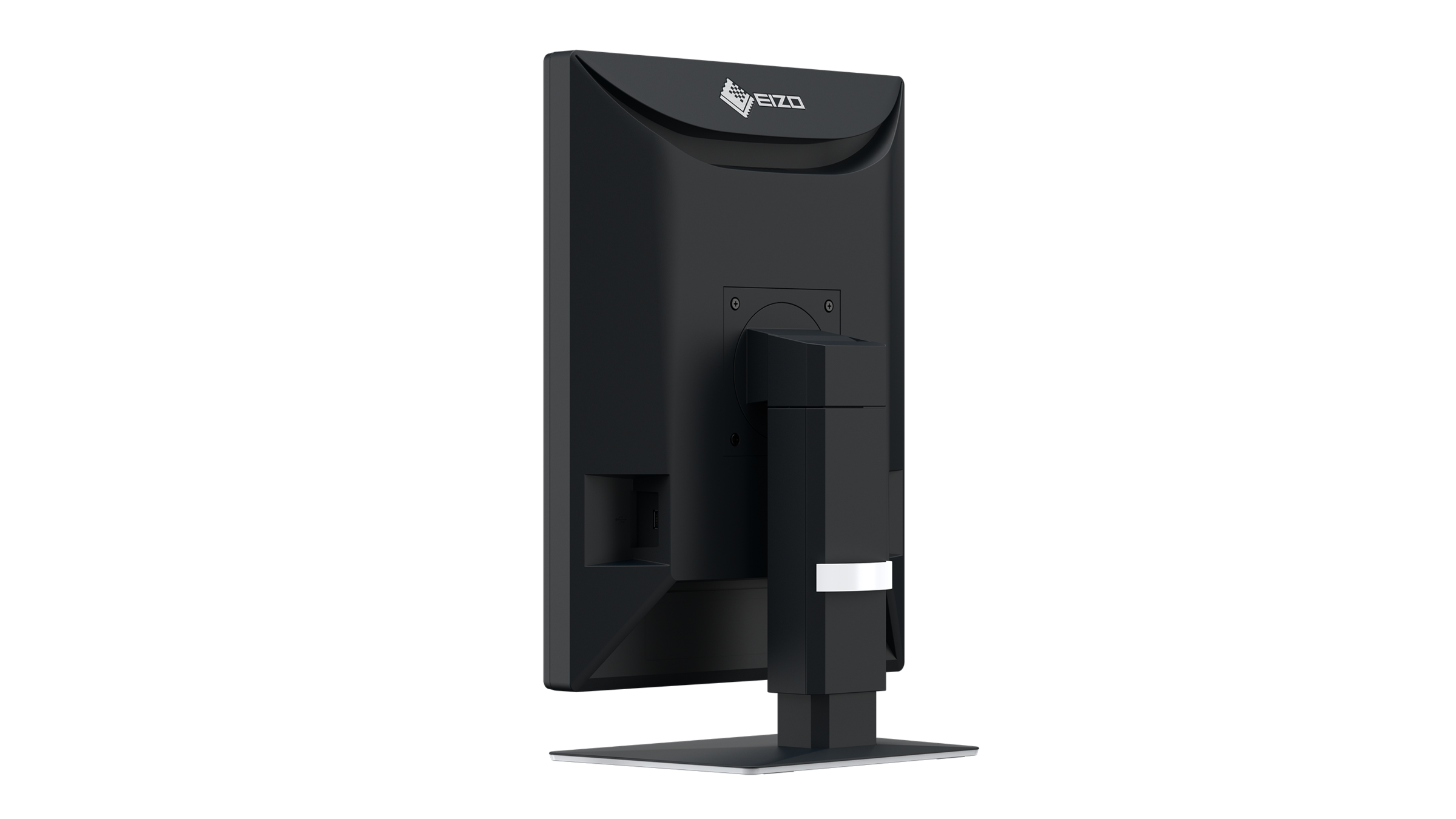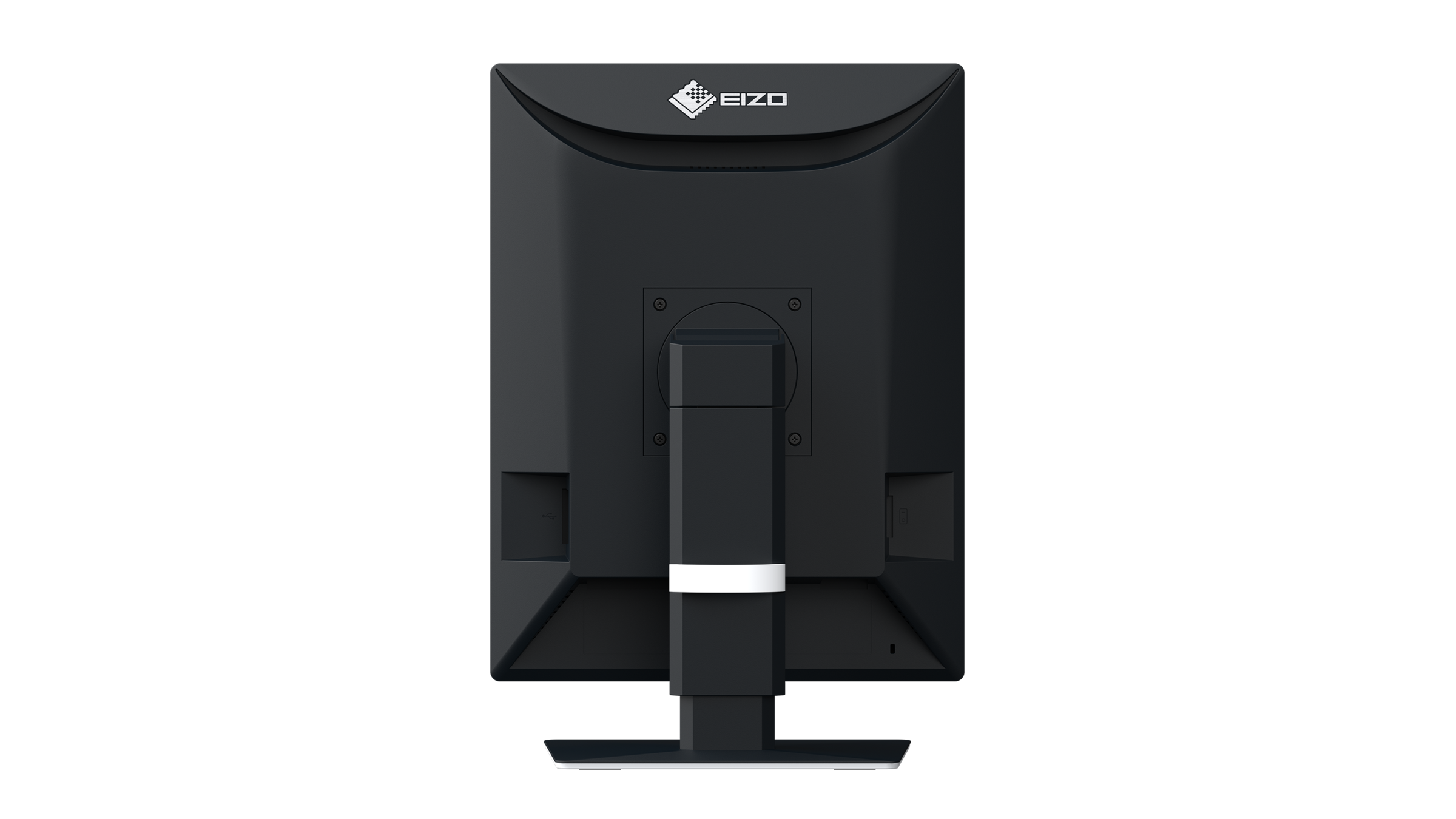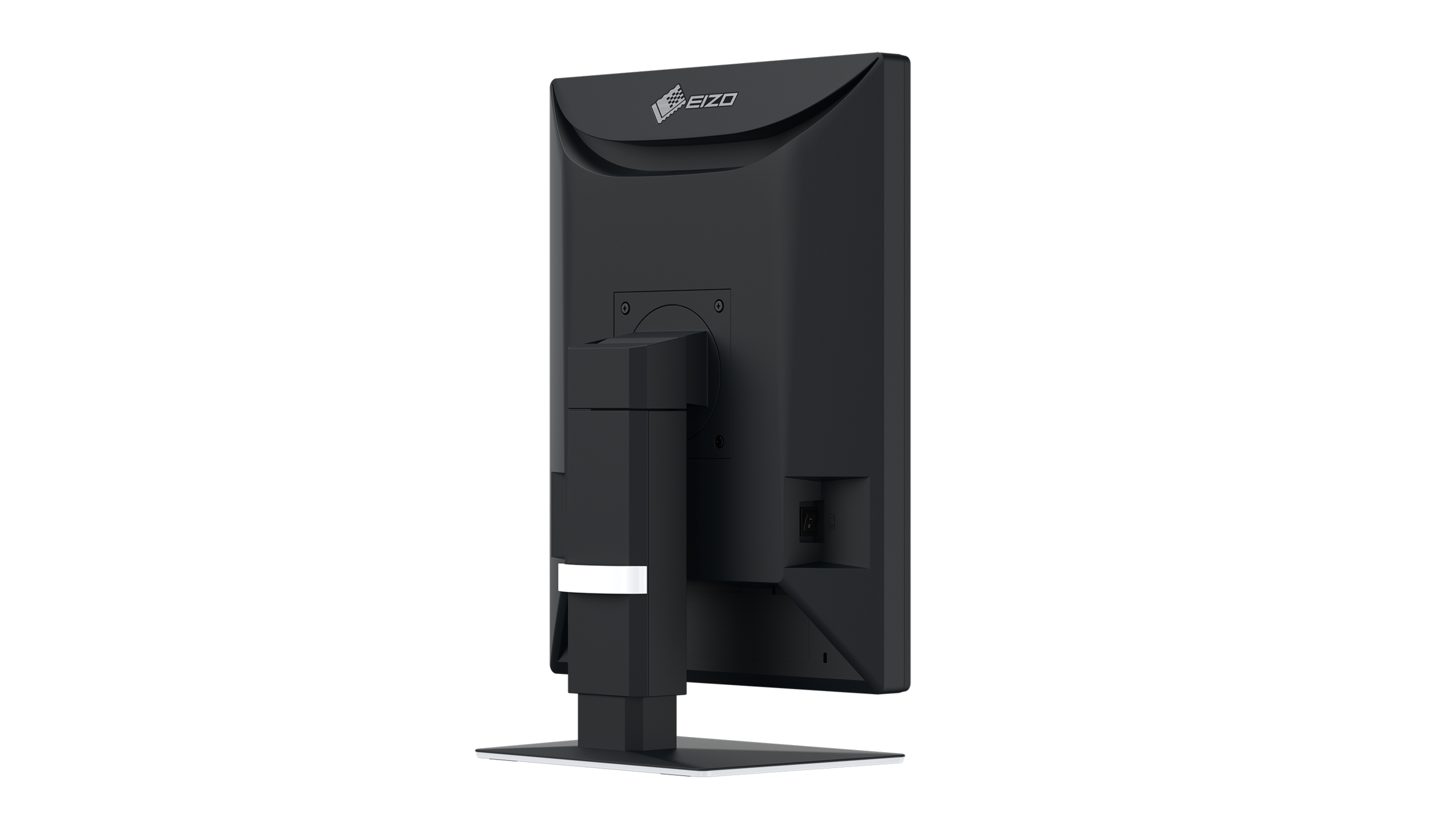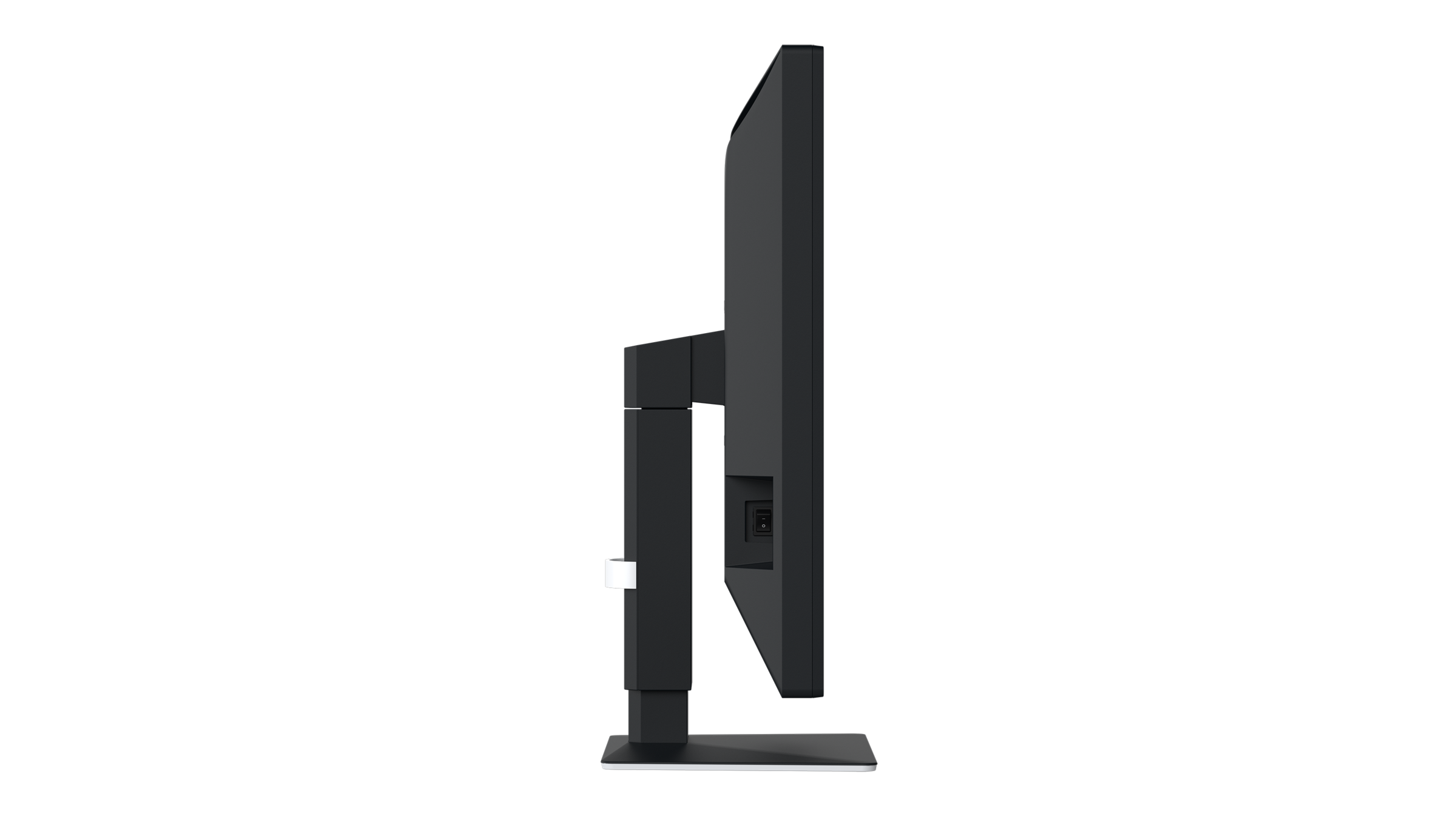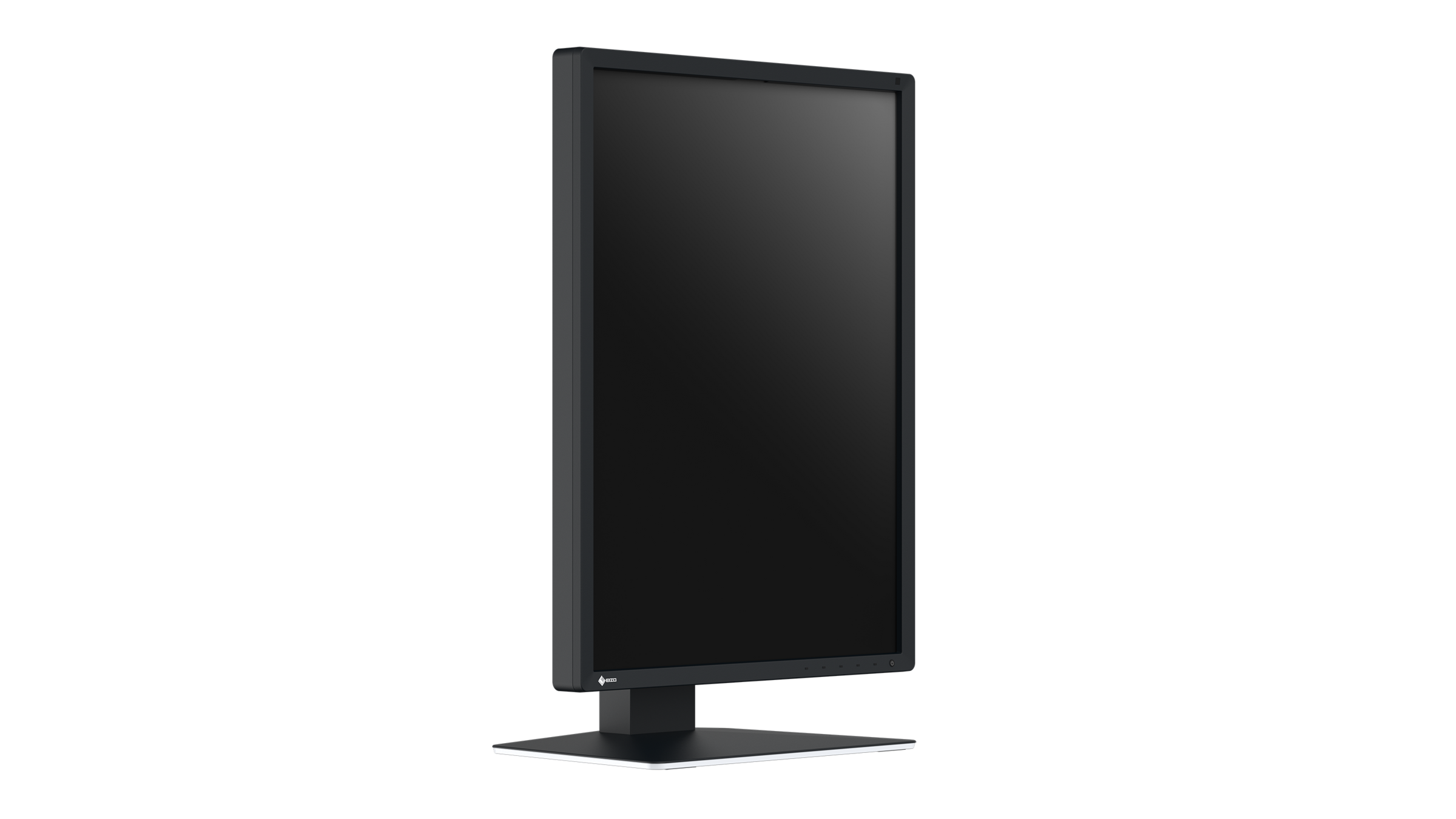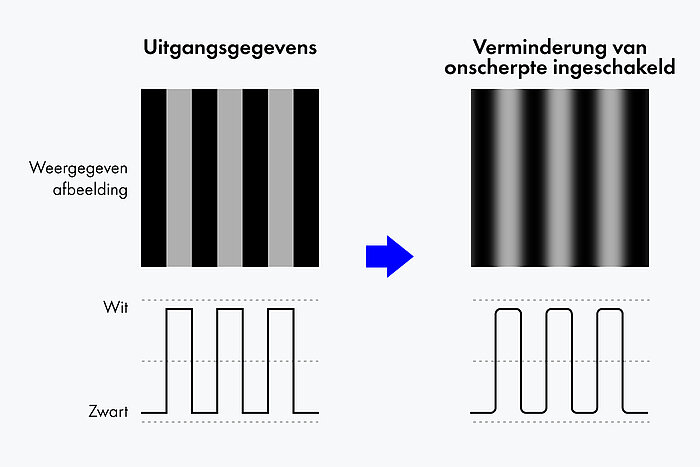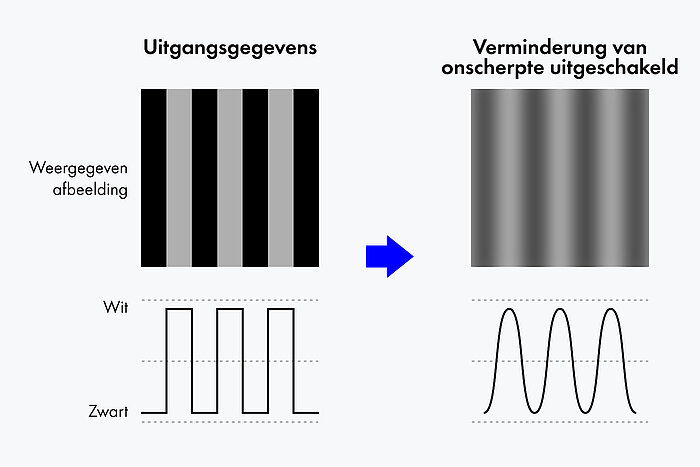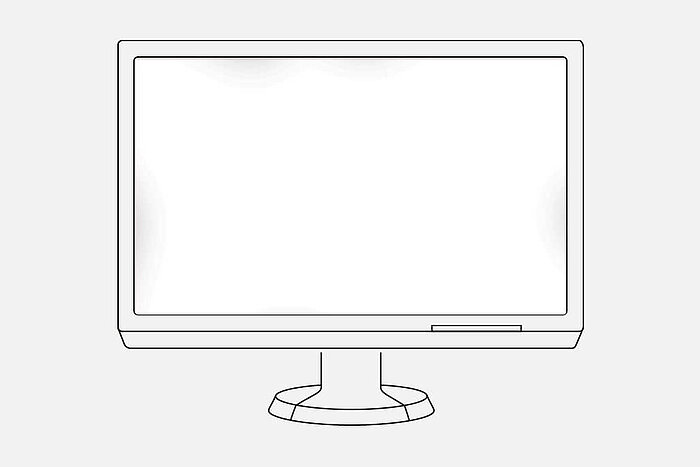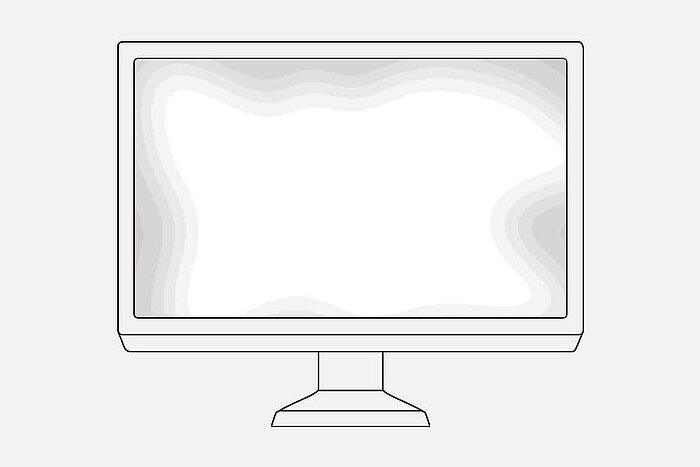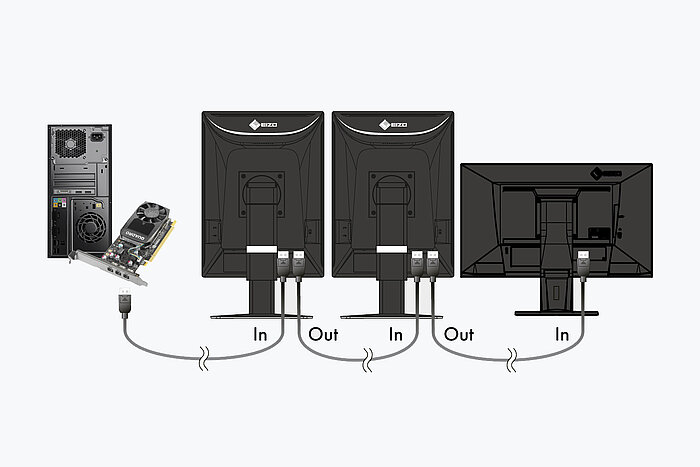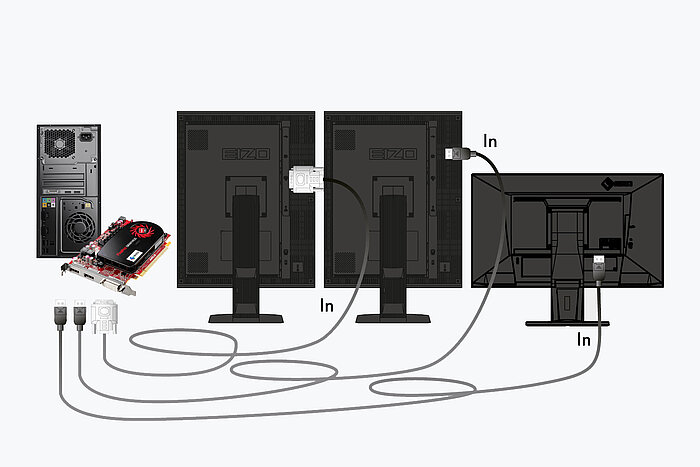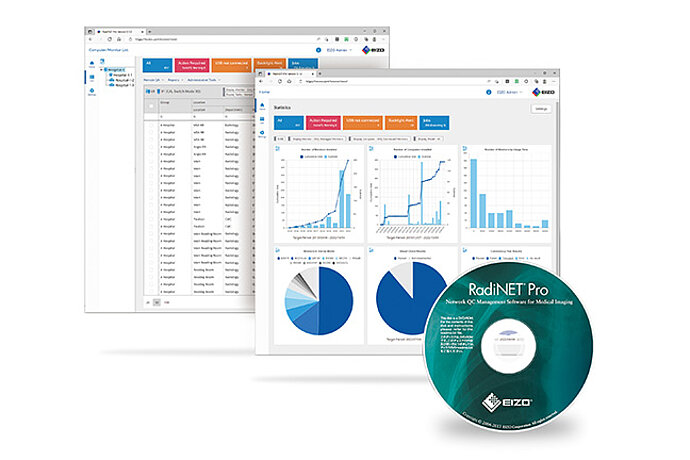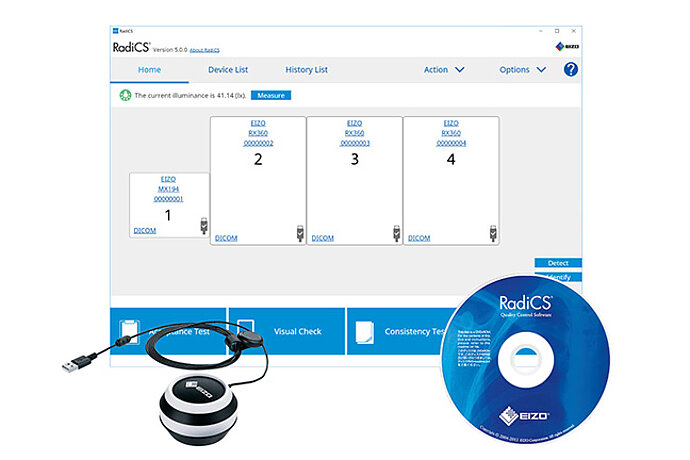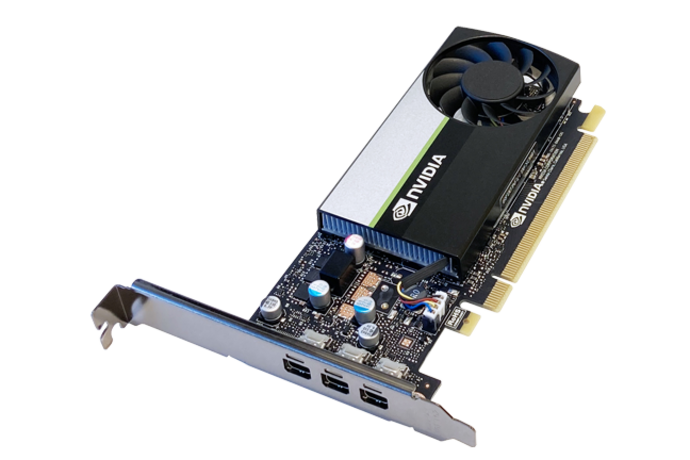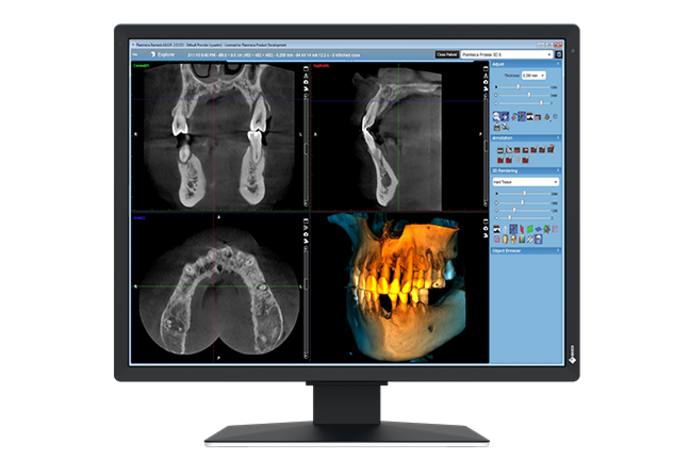MX217-SB RadiForce
2-megapixel kleurenmonitor voor dwarsdoorsnedebeelddiagnose (CT/MRI) en rapportage van tandheelkundige röntgenfoto's in diagnostische ruimten (ruimte klasse 5). 240 cd/m2 gekalibreerde helderheid en DICOM®-GSDF-luminantiekarakteristiek.
- 54 cm (21")
- 2 Megapixels (kleuren)
- 3:4 Formaat
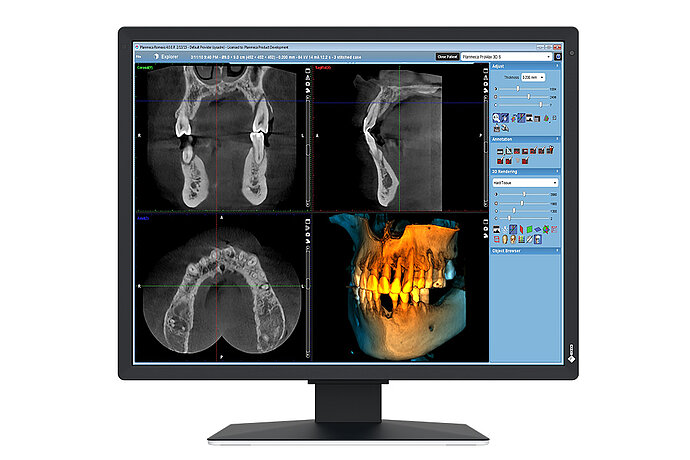
Beeldkwaliteit
Nauwkeurigheid, helderheid, contrast en scherpte
Dankzij een hoge resolutie van 2 Megapixels (kleuren), een sterke contrastverhouding van 1800:1 en een stabiele helderheid van tot maar liefst 500 cd/m2 biedt de monitor een excellente beeldkwaliteit. Zelfs de kleinste details worden gedifferentieerd weergegeven, onafhankelijk van de kijkhoek van waaruit de monitor wordt bekeken. Dit is een groot voordeel als meerdere artsen het beeldscherm bekijken.
Zwart-wit en kleurenafbeeldingen bekijken met slechts één monitor
Met de Hybrid Gamma PXL-functie wordt onderscheid gemaakt tussen monochrome en kleurenbeelden. Automatisch. Pixel per pixel. Op die manier ontstaat een hybride display waarop iedere pixel wordt weergegeven met de optimale toonwaarde. Dit garandeert een hoge precisie en betrouwbaarheid.
De MX217-SB geeft geavanceerde monochrome beelden net zo betrouwbaar weer als kleurenbeelden van alle denkbare modaliteiten. In de praktijk betekent dit een aanzienlijke toename in efficiëntie, omdat beelden van verschillende beeldvormingsprocedures op slechts één monitor kunnen worden weergegeven.
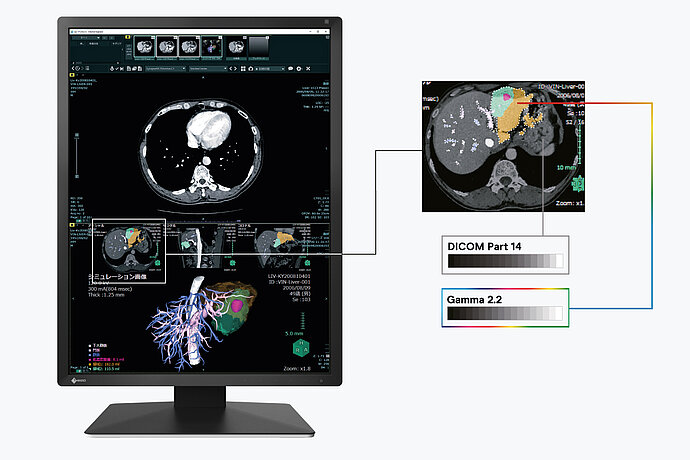
Vermindering van onscherpte
LCD-panels met een hoge helderheid geven afbeeldingen door overbelichting vaak onscherper weer dan het origineel. EIZO biedt daarom een in de monitorhardware geïntegreerde functie voor de vermindering van onscherpte. Deze functie zorgt ervoor dat de details die in de onscherpe randen zijn verdwenen, weer in maximale helderheid op het beeldscherm worden weergegeven.
Eén miljard kleuren dankzij 13-bit-LUT
De kleurweergave gebeurt via een 13-bit-Look-Up-Table (LUT). Bij een DisplayPort-aansluiting kunnen daarvan tot 10 bit worden weergegeven. Dat zorgt voor een resolutie met maximaal 1 miljard kleuren. De voor de diagnose noodzakelijke weergavecurves en detailstructuren zijn daardoor nauwkeurig te herkennen.
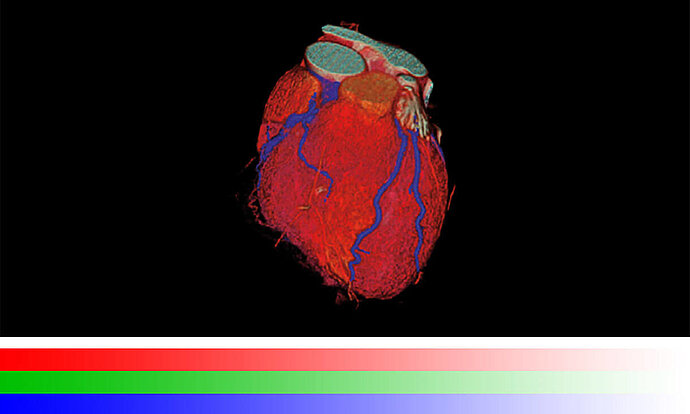
Met 13-bit-LUT
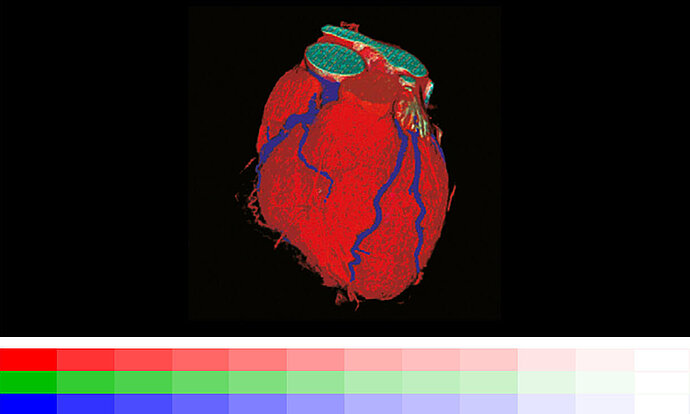
Zonder 13-bit-LUT
Gelijkmatige verlichting en zeer zuivere kleuren
De monitor blinkt uit met een hoge kleurnauwkeurigheid en uniforme verlichting. Dit wordt gegarandeerd door de Digital Uniformity Equalizer (DUE), die onregelmatigheden pixel voor pixel automatisch corrigeert. Grijs- en kleurtinten van radiologische en andere medische beelden worden correct gereproduceerd op het volledige schermoppervlak. Dit is essentieel voor een nauwkeurige beeldweergave.
Consistente beeldkwaliteit dankzij geïntegreerde luminantiesensor
De nauwkeurige kalibratie van witpunt en tonaliteitscurve is gegarandeerd dankzij een in het frame geïntegreerde luminantiesensor. Deze meet helderheid en grijswaarden en kalibreert de monitor zelfstandig conform de DICOM®-standaard. De sensor werkt automatisch, zonder daarbij het zichtveld van de monitor te beperken. U bent minder tijd kwijt aan onderhoud en kunt vertrouwen op een constant hoge beeldkwaliteit.
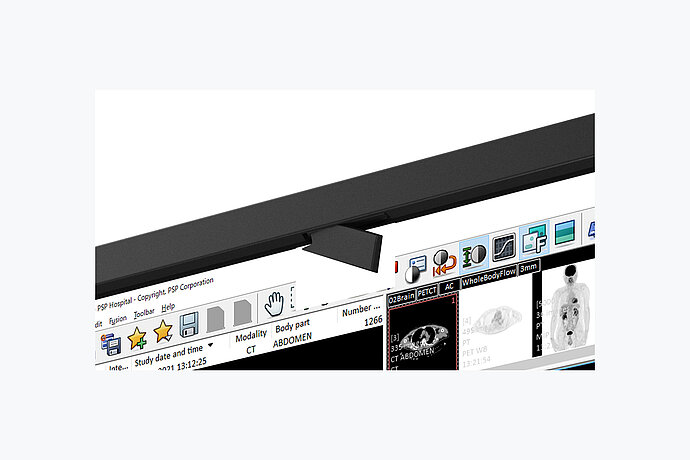
Voorbeeld afbeelding
Constante helderheid tijdens het gebruik
Een sensor voor de achtergrondverlichting bepaalt continu de luminantie van de monitor. Het voordeel: De ingestelde en gekalibreerde waarden worden enkele seconden na inschakeling al exact weergegeven en blijven gedurende de volledige bedrijfsduur constant. De sensor is onzichtbaar in de monitor geïntegreerd.
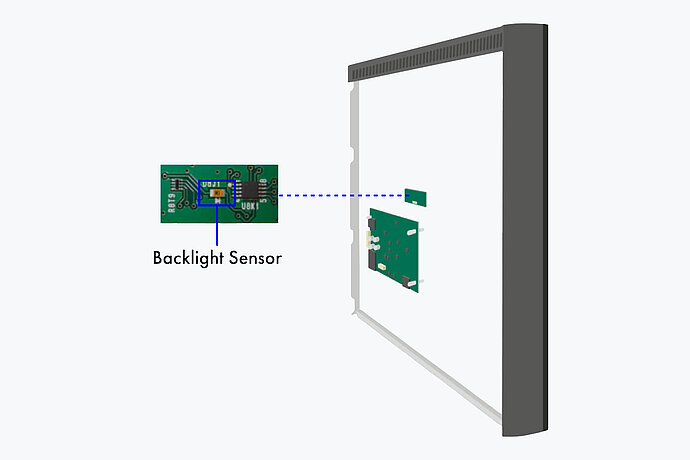
Achterkant van het beeldscherm
FDA-vrijgave
Het beeldscherm bevat de FDA-510(k)-vrijgave voor algemene radiografie, maar ondersteunt geen weergave van mammografiebeelden voor de diagnose.
Software en bedieningsgemak
De uitrusting om comfortabel te werken
De Work & Flow-technologie
Met de toenemende digitalisering van modaliteiten worden radiologen geconfronteerd met een groeiende hoeveelheid informatie op hun scherm. Dankzij de unieke work-and-flow-technologie van EIZO met nieuwe functies die zijn afgestemd op de behoeften van radiologen, wordt de complexiteit van gegevens effectief tegengegaan. Met RadiForce MX217-SB en de meegeleverde RadiCS-LE-software profiteert u van de Work & Flow-functies.
Point-and-Focus: concentratie op het analysebereik
Met de Point & Focus-functie kunt u relevante beeldgebieden snel met de muis of het toetsenbord selecteren en scherpstellen. Door middel van helderheid en grijswaarde worden omringende zones verduisterd, waardoor interessante beeldgebieden beter naar voren komen.
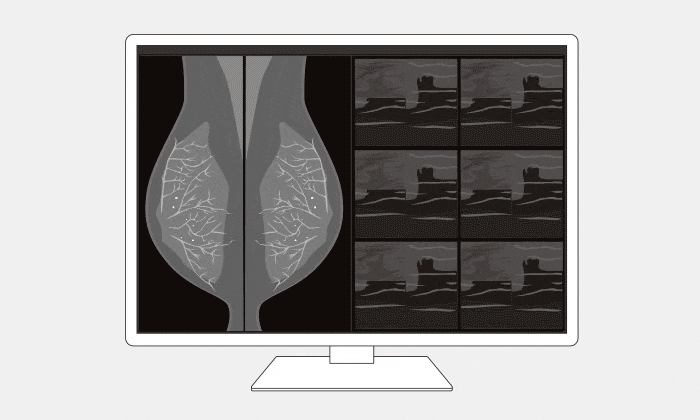
RadiCS LE
Helderheid en DICOM®-tonaliteitscurve kunnen met de software RadiCS LE worden gecontroleerd en automatisch volgens de fabrieksinstelling worden gekalibreerd. Hiervoor is in het apparaat een sensor geïntegreerd. Ook de kalibratie van andere tonaliteitscurves, zoals CIE, is met RadiCS LE mogelijk.
Diagnosecomfort
Efficiency bij de diagnose
Image rotation plus: Steeds de optimale oriëntatie
De MX217-SB kan zowel in landschaps- als in portretformaat gebruikt worden. Het weergegeven beeld wordt afhankelijk van de oriëntatie van de monitor automatisch gedraaid dankzij de functie "Image Rotation Plus" die in de meegeleverde software RadiCS LE geïntegreerd is. (Voorwaarde hiervoor is ondersteuning door de grafische kaart.)
Bovendien garandeert de flexibele voet een optimale ergonomie. U kunt de monitor kantelen of in de hoogte tot op bureauhoogte laten zakken.
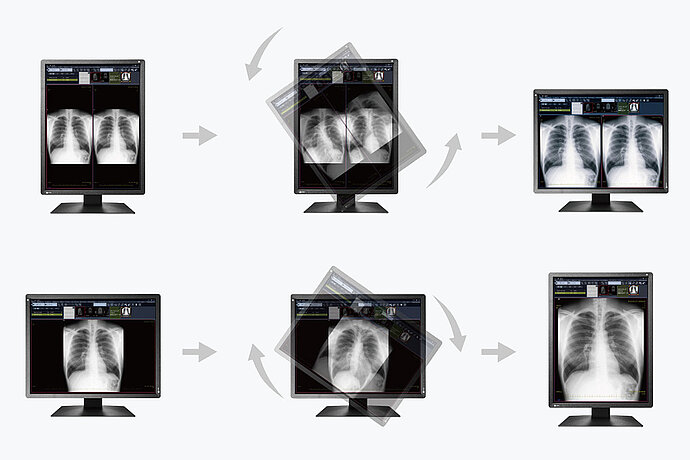
Het weergegeven beeld wordt dankzij de functie Image Rotation Plus afhankelijk van de oriëntatie van de monitor in portret- of landschapsformaat gedraaid.
Daisy-chain-methode
Efficiënte opstelling met meerdere monitoren
Via de signaalin- en uitgang kunt u meerdere RadiForce-monitoren met de DisplayPort-interface aan elkaar koppelen. Zo kunt u multischermoplossingen zeer eenvoudig realiseren, zonder een wirwar aan kabels.
Met één druk op de knop wordt de DICOM®-luminantiecurve weergegeven
EIZO meet elke grijstint en past deze nauwkeurig aan, zodat de monitoren af fabriek al aan de DICOM®-standaard voldoen. Het resultaat is een bijzonder consistent scala aan grijswaarden, wat optimaal duidelijke radiologische beelden oplevert.
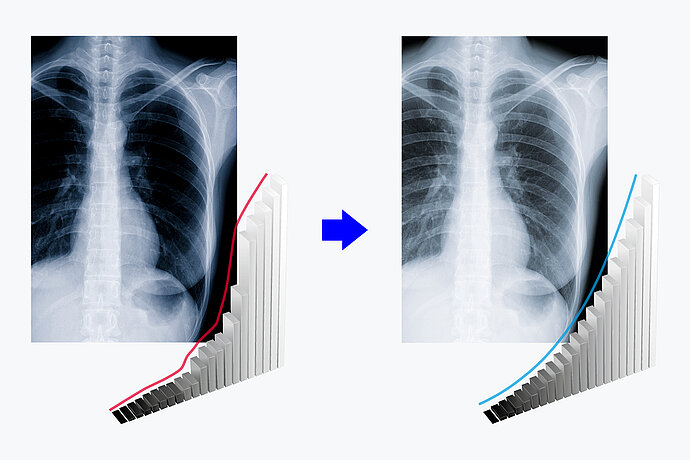
RadiLight: Comfortverlichting van EIZO is vriendelijk voor de ogen
EIZO presenteert de nieuwe RadiLight, een speciale, gebruiksvriendelijke comfortverlichting voor radiologen, die in donkere verslagruimten werken. Het zachte licht achter de monitor voorkomt een overmatige inspanning van de ogen, die zich normaal gesproken snel voor kan doen als de ogen in een donkere omgeving met een licht monitorscherm continu wisselen tussen licht en donker.
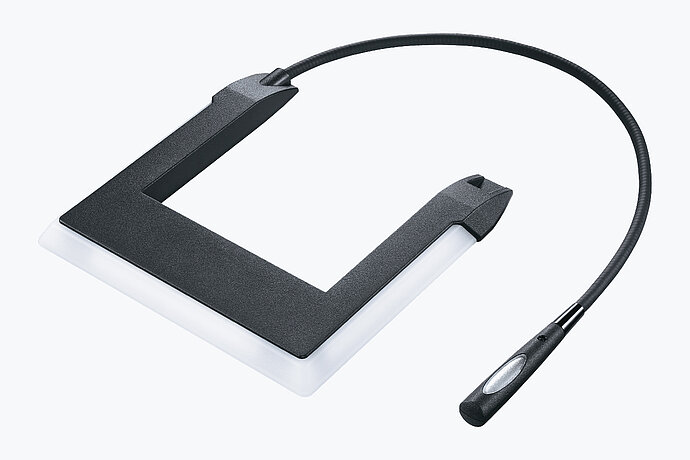
Duurzaamheid
Milieu- en sociaal bewuste productie
Milieuvriendelijke verpakking
Voor de verpakking van het MX217-SB gebruikt EIZO een vulling van cellulose. Het materiaal is gemaakt van gerecycleerd karton en papier, en heeft een veel geringer milieueffect wanneer het wordt weggegooid dan traditioneel polystyreen of plastic. Alle kabels worden opgeborgen in een kartonnen compartiment in plaats van in plastic zakken.
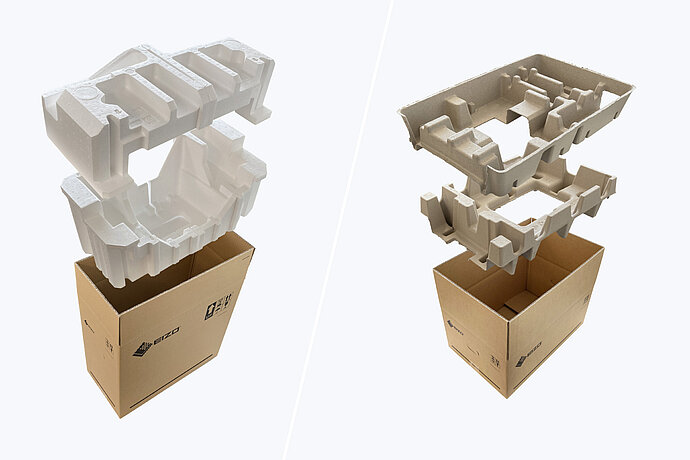
Links: conventionele verpakking / Rechts: milieuvriendelijke materialen
Maatschappelijk verantwoorde productie
De MX217-SB wordt op een maatschappelijk verantwoorde manier vervaardigd. Onze productie is vrij van kinderarbeid en dwangarbeid. De leveranciers in de volledige leverketen zijn zorgvuldig geselecteerd en zijn ook verplicht om op een maatschappelijk verantwoorde manier te produceren. Dit geldt vooral voor de zogeheten conflictmineralen. Ieder jaar dienen we vrijwillig een uitgebreid rapport in over onze maatschappelijke verantwoordelijkheid.
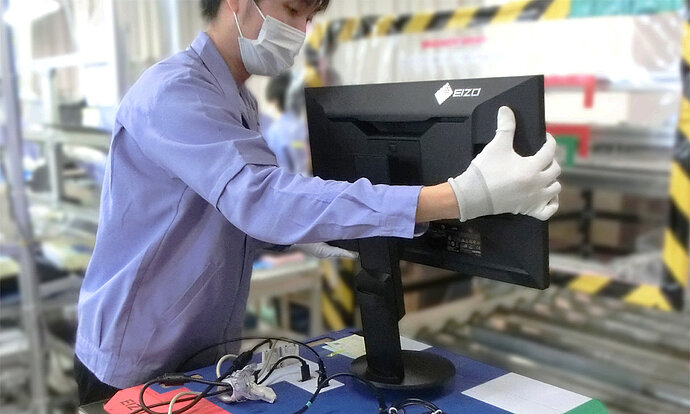
Milieu- en klimaatvriendelijk
Iedere MX217-SB wordt in onze eigen fabriek geproduceerd. Onze fabriek werkt met een milieu- en energiebeheersysteem conform ISO 14001 en ISO 50001. Dit omvat onder andere maatregelen voor de vermindering van afval, afvoerwater, uitstoot en verbruik van grondstoffen en energie. Ook wordt milieubewust gedrag van de medewerkers gestimuleerd. We leggen jaarlijks openbaar verantwoording af over deze maatregelen.
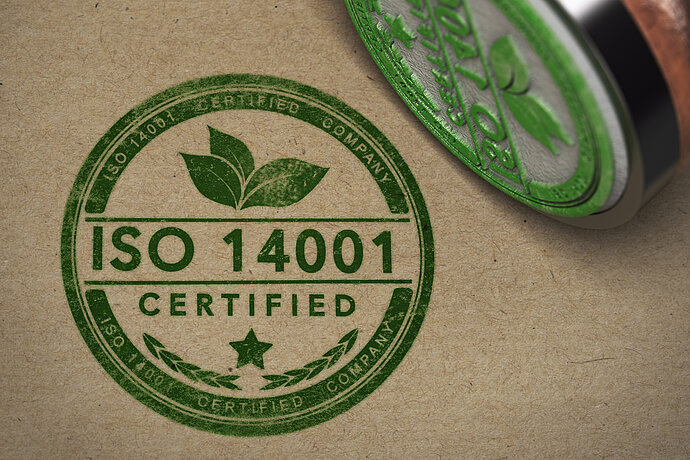
Duurzaam en met een lange levensduur
De MX217-SB is ontwikkeld voor een lange gebruikslevensduur – in het algemeen veel langer dan de garantieperiode. Vervangende onderdelen blijven nog vele jaren beschikbaar, nadat de monitor uit productie is genomen. De volledige gebruikslevensduur houdt rekening met de effecten op het milieu, omdat duurzaamheid en reparatiemogelijkheden de natuurlijke hulpbronnen beschermen en daarmee ook het milieu. Bij het ontwerp van de MX217-SB hebben we veel aandacht besteed aan een laag grondstoffenverbruik, met hoogwaardige componenten en materialen, en een zorgvuldige verwerking in de productie.
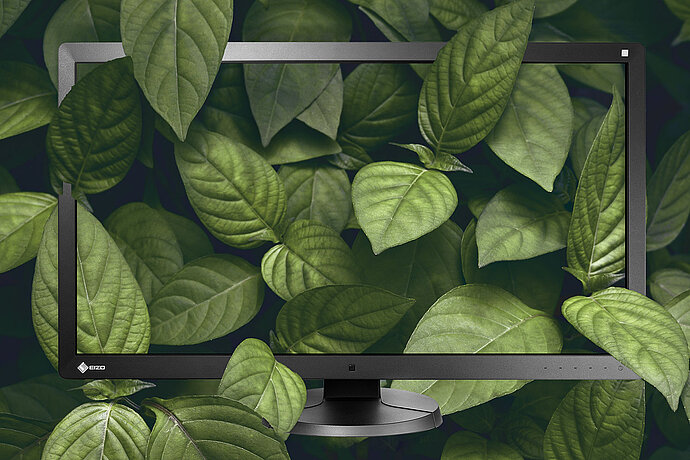
Milieuvriendelijk gebruik van materialen
Het MX217-SB bestaat voor ongeveer 19% uit gerecycleerd plastic. Dit vermindert de hoeveelheid plastic afval die in het milieu terechtkomt, bespaart grondstoffen en bevordert het hergebruik van materialen om natuurlijke ecosystemen te behouden.
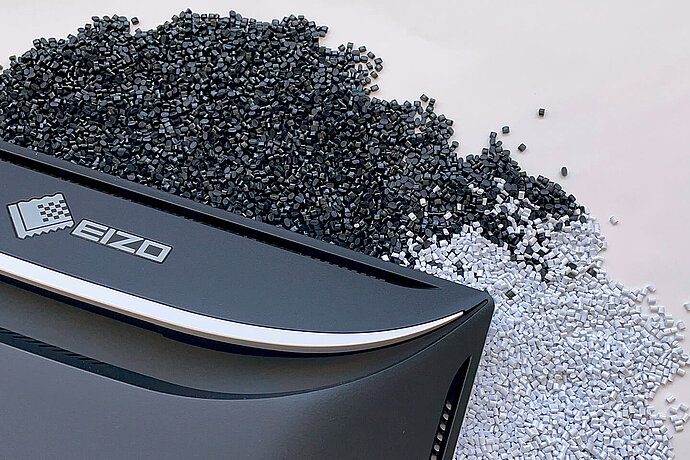
Garantie
Maximale investeringszekerheid
Vijf jaar garantie
EIZO biedt vijf jaar garantie inclusief on-site omruilservice. Wij kunnen dit bieden dankzij een ingenieus productieproces, dat is gebaseerd op een eenvoudige succesformule: doordachte en innovatieve techniek, gefabriceerd met high-end-materialen.

Advies over grafische kaarten
Voor nauwkeurige diagnoses
EIZO Grafische kaart MED-XN43
De EIZO grafische kaart ondersteunt de eigenschappen, functies en instellingen van de RadiForce MX217-SB optimaal. Het maakt nauwkeurige rapportage mogelijk en kan meerdere monitoren tegelijk aansturen. EIZO biedt technische ondersteuning en garantieservice voor de grafische kaart.
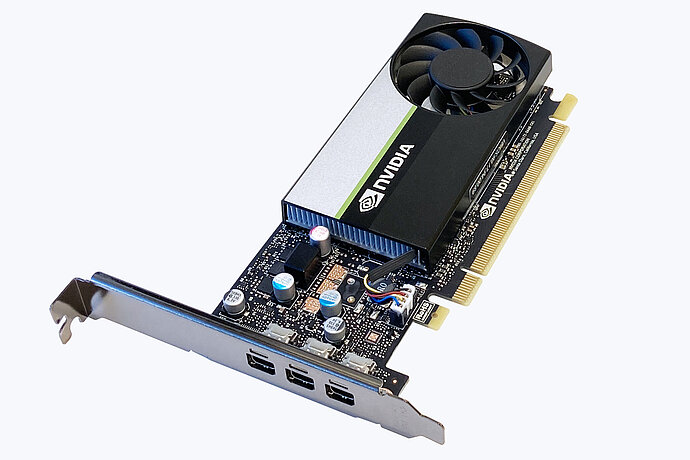
Passende accessoires
Mist u nog iets?
Technische gegevens
| Algemeen | |
|---|---|
| Artikelnr. |
MX217-SB
|
| Behuizingskleur |
Zwart
|
| Toepassingsgebied | Medisch |
| Productlijn | RadiForce |
| Toepassingsgebied | Computertomografie en MR-beeldvorming, Tandarts, Tandheelkundige diagnostische ruimte, Non-destructive-testing |
| EAN |
4995047065067
|
| Scherm | |
|---|---|
| Diagonaal [in inch] | 21 |
| Diagonaal [in cm] | 54 |
| Formaat | 3:4 |
| Zichtbare beeldgrootte (breedte x hoogte) [in mm] | 324 x 432 |
| Resolutie in megapixel | 2 Megapixels (kleuren) |
| Ideale en aanbevolen resolutie | 1200 x 1600 |
| Pixelafstand [in mm] | 0,27 x 0,27 |
| Ondersteunde resoluties | 1200 x 1600 |
| Panel technologie | IPS |
| Max. kijkhoek horizontaal | 178 |
| Max. kijkhoek verticaal | 178 |
| Weergavekleuren of grijswaarden | 1,07 miljard kleuren (DisplayPort, 10 bit), 16,7 miljoen kleuren (DVI, 8 bit), 16,7 miljoen kleuren (DisplayPort, 8 bit) |
| Kleurenpalet/Look-Up-Table | 543 miljard kleurgradaties / 13 bit |
| Max. helderheid (standaard) [in cd/m²] | 500 |
| Af fabriek gekalibreerde helderheid [in cd/m²] | 240 |
| Max. darkroomcontrast (standaard) | 1800:1 |
| Backlight | LED |
| Functies en bediening | |
|---|---|
| Vooraf ingestelde kleur-/grijswaardenmodi | 1x manuele geheugenplaats, Text, sRGB, Paper, DICOM, extra geheugenruimte door kalibratie |
| DICOM curve | |
| Hardwarekalibratie van helderheid en luminantiecurve | |
| Digital Uniformity Equalizer (homogeniteitscorrectie) | |
| Hybrid Gamma PXL | |
| Blur reduction | |
| Sensoren | Omgevingslichtsensor, Geïntegreerde luminantiesensor, Backlightsensor |
| On-Screen menu talen | de, en, fr, es, it, se |
| Instelmogelijkheden | DICOM- kleurtooncurven, Helderheid, Contrast, Kleurtemperatuur/Witpunt, Gamma, Kleurverzadiging, Resolutie, Schaling, Kleurenmodus overslaan, OSD-taal, Signaalingang, Sleutelslot, Vermindering van onscherpte |
| Geïntegreerde voeding | |
| Aansluitingen | |
|---|---|
| Signaalingangen | DisplayPort, DVI-D |
| Signaaluitgangen | 1x DisplayPort (HDCP 1.2) |
| Geschikt voor daisy-chain | |
| USB-specificatie | USB 2 |
| USB-upstream-poorten | 1 x type B |
| USB-downstream-poorten | 2x type A |
| Grafisch signaal | DVI Single Link (TMDS), DisplayPort |
| Energie informatie | |
|---|---|
| Frequentie | Digital: 31-100 kHz/59-61 Hz |
| Energieverbruik (standaard) [in watt] | 23 |
| Maximaal energieverbruik [in watt] | 54 (bij maximale helderheid en gebruik van alle signaal- en USB-poorten) |
| Energieverbruik (Stand-by) [in watt] | 0.6 |
| Energieverbruik als netschakelaar is uitgeschakeld [in watt] | 0 |
| Voeding | AC 100-240V, 50/60Hz |
| Afmetingen & gewicht | |
|---|---|
| Afmetingen (incl. standaard) (breedte x hoogte x diepte) [in mm] | 357 x 482-572 x 200 |
| Gewicht (incl. standaard) [in kg] | 7.3 |
| Technische tekening (PDF) | Technische tekening (PDF) |
| Draaibaarheid van de standaard [in °] | 70 |
| Kantelbaarheid voor/achter [in °] | 5 / 30 |
| Rotatie liggend en staand formaat (Pivot) | linksom |
| Gatafstand | 100 x 100 |
| Certificering & normen | |
|---|---|
| Certificering | CE (Medical Device), UKCA (Medical Device), ANSI/AAMI ES60601-1, CSA C22.2 Nr. 601-1, EN60601-1, IEC60601-1, RCM, FCC-B, CAN ICES-3 (B), VCCI-B, RoHS, WEEE, China RoHS, CCC |
| Software & Accessoires | |
|---|---|
| Bijbehorende software en verdere accessoires beschikbaar als download | RadiCS LE |
| Meegeleverde accessoires | USB-kabel (type A - type B), Signaalkabel DisplayPort - DisplayPort, Handleiding via download, Voedingskabel |
| Optionele accessoires | RadiNET Pro, RadiCS (UX2-Kit), MED-XN43 |
| Aanbevolen grafische kaart | MED-XN43 |
| Garantie | |
|---|---|
| Garantieperiode | 5 jaar |
| Type garantie | Omruilservice op locatie |
Downloads en ondersteuning
Rondom uw product
Handleidingen & documenten
Software
Veelgestelde vragen
Garantie
Handleidingen & documenten
Handleiding - MX217-SB
Datasheet - MX217-SB
Product afbeeldingen MX217-SB
Recommended graphics cards for RadiForce monitors
RadiForce Brochure
(Engels)
Software
Stuurprogramma - MX217-SB
Monitortest
Met behulp van door EIZO zelf ontwikkelde software kunt u snel en eenvoudig de eigenschappen en instellingen van uw eigen monitoren testen.
RadiCS
Met de software van EIZO kunt u het volledige kwaliteitsbeheerproces aansturen - van de kalibratie en het asset-management tot aan de overdrachts- en consistentiecontrole.
RadiCS LE
RadiCS LE is kwaliteitsmanagementsoftware waarmee u EIZO RadiForce-monitoren kunt kalibreren en kalibratiegegevens kunt beheren.
RadiNET Pro
Speciale software van EIZO voor netwerkondersteund kwaliteitsbeheer in grote installaties. Met functionaliteit voor externe bediening van monitoren.
Veelgestelde vragen
EIZO heeft speciaal voor de kwaliteitsborging bij beeldweergaveapparaten uit de RadiForce-serie die worden gebruikt in medische toepassingen de software RadiCS ontwikkeld. Deze softwaresuite omvat uitgebreide testen en functionaliteit voor automatische aanpassing, waardoor een constante en consistente beeldweergave op alle RadiForce-monitoren kan worden gewaarborgd. De software doorloopt automatisch de testafbeeldingen waardoor metingen en evaluaties in overeenstemming met het beleid kunnen worden uitgevoerd, en tijd en kosten bespaard worden. Meetresultaten worden bijvoorbeeld automatisch opgeslagen in documentatie en worden gearchiveerd, en kunnen dan met de optionele software RadiNET Pro centraal worden beheerd en verwerkt. Ook is de software voorzien van een agenda met herinneringsfunctie zodat controles regelmatig en tijdig worden uitgevoerd. Om de luminantie te kunnen meten, met inbegrip van de sluierluminantie, is een geschikt meetapparaat vereist. RadiCS is in staat om de meetwaarden te lezen van de meest uiteenlopende luminantiemeters.
Volgens het ministerie van Milieu, Natuurbescherming en Nucleaire Veiligheid (BMU) is de richtlijn aangaande de kwaliteitsborging conform de Röntgenverordening (QS-RL): “Uitvoering van kwaliteitsborging bij röntgeninstallaties die worden gebruikt voor onderzoek en de behandeling van mensen“ normbepalend.
De norm DIN V 6868-157 reguleert de overdrachtscontrole en de consistentiecontrole van beeldweergavesystemen voor radiografie om de daarvoor vereiste beeldkwaliteit te waarborgen.
Afhankelijk van het onderzochte lichaamsgebied en de toegepaste methodiek gelden conform DIN 6868-157 verschillende minimumvereisten voor weergaveapparatuur. Aan de hand van EIZO's software voor kwaliteitsborging RadiCS kunnen deze vereisten worden onderverdeeld in de klassen I tot en met VIII. In de volgende tabel kunt u een overzicht bekijken van alle afzonderlijke klassen en de bijbehorende minimumvereisten.
Let op: Voor elk beeldweergavesysteem dat wordt gebruikt voor diagnosticering conform DIN 6868-157, moet een overdrachtscontrole worden uitgevoerd.
Het wordt aanbevolen om uw monitor regelmatig te reinigen. Hierdoor ziet de monitor er niet alleen als nieuw uit, maar wordt ook de levensduur en de bruikbaarheid verlengd. U kunt de behuizing en het LCD-schermoppervlak reinigen zoals hieronder wordt beschreven:
BELANGRIJK: Gebruik nooit thinner, benzeen, alcohol (ethanol, methanol of isopropanol), schuurmiddelen of andere sterke oplosmiddelen, want deze kunnen schade aan de behuizing of het LCD-scherm veroorzaken.
Behuizing
Vlekken op de behuizing kunt u verwijderen door deze weg te vegen met behulp van een zachte, licht bevochtigde doek en een mild reinigingsmiddel. Spuit in geen geval was of andere reinigingsmiddelen rechtstreeks op de behuizing. (Raadpleeg de handleiding voor gedetailleerde informatie)
LCD-scherm
Gebruik voor reiniging van het schermoppervlak een zachte doek (bijvoorbeeld een katoenen doek of een brillenpoetsdoekje). Hardnekkige vlekken kunnen meestal worden verwijderd door de doek met wat water te bevochtigen.
Voor de meest nauwkeurige beeldweergave zijn een homogene luminantieverdeling en een goede kleurechtheid van essentieel belang. Hiervoor zorgt ons DUE-circuit, de Digital Uniformity Equalizer. Deze speciale functionaliteit corrigeert bij elke tonaliteit en over het gehele beeldoppervlak automatisch oneffenheden van de luminantie en chrominantie, pixel voor pixel.
De looptijd van de garantie op EIZO RadiForce-monitoren bedraagt voor de meeste modellen 5 jaar, en deze garantie is inclusief on-site omruilservice. EIZO beveelt voor medische beeldschermen een helderheid aan die ruim boven de minimumvereisten conform QS-RL ligt. Deze aanbevolen helderheid wordt door EIZO gegarandeerd.
Welke garantie voor elk RadiForce-model van toepassing is, is te vinden in de bijbehorende productinformatie die bij elk model wordt meegeleverd.
Via de installatiewizard voor RadiCS 5 en met de daarvoor bestemde functie in RadiNET Pro wordt een gegevensmigratie voor u verzorgd.
Let wel: u moet daarvoor minstens RadiCS 4-versie 4.6.1 hebben. Hebt u een oudere versie van RadiCS 4? Voer dan eerst een update uit.
EIZO-monitoren ondersteunen DisplayPort Alternate Mode met hun USB-C-interface. Dit betekent dat ze beeldsignalen van Thunderbolt 3- of Thunderbolt 4-poorten via een USB-C-verbinding correct kunnen weergeven. De USB-C-signaalkabel die EIZO bij de monitor levert, is optimaal geschikt.
Als alternatief kunnen monitoren met een DisplayPort-aansluiting worden aangesloten met behulp van een geschikte kabel. De door EIZO meegeleverde CP200 signaalkabel (USB-C (TB3/TB4) naar DisplayPort) is het meest geschikt.
Een verbinding van Thunderbolt 3- of Thunderbolt 4-poorten naar de HDMI-interface van de monitor kan werken met geschikte actieve adapters/kabels. Wij raden echter aan de USB-C- of DisplayPort-interface van de monitor te gebruiken.
Voorbereiding op de verplaatsing:
Controleer eerst of RadiCS geopend kan worden op de vorige computer. Ons advies: Werk RadiCS op de vorige computer indien nodig bij naar dezelfde versie die u op de nieuwe computer gaat gebruiken.
Uitvoering van de verplaatsing:
- Stop de RadiCS5Service onder Services op de vorige computer.
- Kopieer de map db en de back-upmap onder C:\ProgramData\RadiCS5 (verborgen map) naar een geschikt opslagmedium of netwerkstation.
- Installeer de huidige RadiCS5-versie op de nieuwe computer (als u RadiNET Pro gebruikt, moet het RadiCSGatewaySettings.xml-bestand zich in de RadiCS-installatiemap bevinden).
- Stop nu de RadiCS5-service onder Services.
- Hernoem de map db en de map back-up in de map RadiCS5 op de nieuwe computer naar _db en _Backup.
- Kopieer de db- en back-upmappen van de vorige computer van het opslagmedium naar de RadiCS5-map C:\ProgramData\EIZO\RadiCS5 van de nieuwe computer.
- 7. Start de RadiCS5Service.
- Open nu RadiCS5 en controleer of alle gegevens zijn hersteld.
Garantie
EIZO biedt een garantie van maximaal vijf jaar, maar voor sommige producten geldt een andere garantietermijn. De exacte garantietermijnen voor elk product vindt u in de bovenstaande garantievoorwaarden, in het gegevensblad of op de internationale EIZO-website. De lange garantietermijnen worden mogelijk gemaakt door een hoogontwikkeld productieproces dat is gebaseerd op een eenvoudig succesprincipe: geavanceerde en innovatieve monitortechnologie, vervaardigd van hoogwaardige materialen. Voor u betekent de 5 jaar garantie een hoge mate van investeringszekerheid en besparing op vervolgkosten (total cost of ownership), die zonder garantieservice bijvoorbeeld voor onderhoud en reparaties zouden ontstaan.
